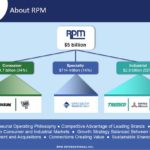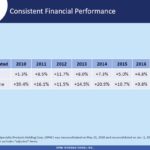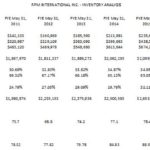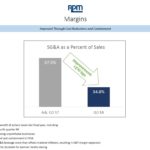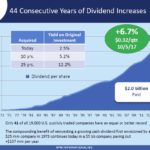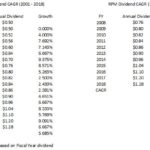Contents
Summary
- This RPM stock analysis is based on Q3 2018 results released on April 5, 2018.
- RPM increased its dividend in October 2017 thus marking its 44th consecutive year of dividend increases. The dividend compound annual growth rate for the 2001 – 2018, however, is only ~5.7%.
- RPM’s returns since May 31, 2007 have outperformed the S&P500 by ~70% and outperformed its current Peer Group by ~28%.
- RPM has taken on considerable debt in recent years and the company flagged this as a Risk Factor in its 2017 Annual Report.
- Days of Inventory Outstanding has increased from ~69 days for FY2012 to ~85.5 days for FY2017.
- The pullback in RPM’s stock price of ~$54.50 as at the beginning of January 2018 to ~$47 as at April 6, 2018 has reduced the forward adjusted diluted PE level based on projected earnings to ~15.3. Despite this pullback, I am reluctant to initiate a position in RPM.
Introduction
I am constantly seeking attractive companies in which I would be prepared to invest for the long-term. I do not seek speculative investments nor do I seek investments which will require me to closely monitor price changes so I can quickly enter and exit a position. I want to invest in companies for the long-term.
Based on my preliminary observations, RPM International Inc. (NYSE: RPM) appears to fit some of my investment requirements.
RPM’ roots date back to 1947 when Republic Powdered Metals was founded. In 1971, RPM was formed to develop a more aggressive acquisition program in a rapidly consolidating paint and coatings industry.
Industry Analysis
RPM operates in the Specialty Chemicals industry in which there are much larger industry participants. All of the companies listed below are larger from a market cap perspective with Sherwin Williams being at the high end with a ~$36B market cap and Albemarle being at the low end with a market cap of ~$10.2B; RPM’s market cap is ~$6.3B.
- Sherwin –Williams (SHW)
- PPG Industries (PPG)
- Eastman Chemical (EMN)
- Westlake Chemical (WLK)
- Celanese (CE)
- Albemarle (ALB)
While RPM faces the following risks, many of its competitors face similar (if not the same) risks.
- Continuous product innovation is necessary to counteract the risks of product commoditization within the product lifecycle;
- Companies must clearly communicate how and why their products add value and perform relative to competitors’ products;
- Raw material costs are a significant cost component and optimizing procurement processes is critical in order to drive down costs;
- RPM has experienced, and expects to continue to experience, increased competitive pricing pressure;
- Global economic uncertainty continues to exist, including uncertainty relating to the United Kingdom’s vote to leave the European Union (“Brexit”);
- Operations could be adversely affected by global economic conditions if global markets decline in the future, whether related to Brexit or otherwise. This may result in decreased revenue, gross margin, earnings or growth rates and difficulty in managing inventory levels and collection of customer receivables.
Business Analysis
RPM’s subsidiaries manufacture, market and sell various specialty chemical product lines, including high-quality specialty paints, protective coatings, roofing systems, sealants and adhesives, focusing on the maintenance and improvement needs of the industrial, specialty and consumer markets.
Its subsidiaries market products in ~168 countries and territories and operate manufacturing facilities in approximately 139 locations in the United States, Argentina, Australia, Belgium, Brazil, Canada, Chile, China, Colombia, France, Germany, India, Italy, Malaysia, Mexico, The Netherlands, New Zealand, Norway, Poland, Saudi Arabia, South Africa, South Korea, Spain, Sweden, Turkey, the United Arab Emirates, and the United Kingdom.
Approximately 36% of sales are generated in international markets through a combination of exports to and direct sales in foreign countries.
RPM operates through 3 Business Segments.
Source: RPM - Gabelli Specialty Chemical Conference March 13 2018
The following images provide an overview of what segments generate business and with which products.
Source: RPM - Gabelli Specialty Chemical Conference March 13 2018
While RPM may have been growing in the past, the last few years have certainly been a challenge from a Sales and Net Income growth perspective. This is certainly not encouraging.
Source: RPM - Gabelli Specialty Chemical Conference March 13 2018
Impact of the Tax Cuts and Jobs Act (TCJ) on RPM
RPM’s Q3 2018 corporate income tax rate was reduced from 35% to 21% as a result of significant tax law changes and modifications introduced through the TJC. Effective January 1, 2018, RPM’s current fiscal year federal statutory rate is reduced to a blended rate of ~29.2%. This takes into consideration the expected 26% - 27% income tax rate for Q4 2018.
There are certain provisions of the Act which will impact RPM in fiscal 2019. RPM is evaluating the impact of these provisions on future fiscal years with respect to permanent reinvestment of foreign earnings based on various factors (ie. future liquidity needs, RPM’s global capital structure, and the foreign tax implications of future earnings repatriations).
Q3 2018 Results and Forecast
On April 5, 2018, RPM released its Q3 results and provided guidance on the remainder of the current fiscal year which ends May 31, 2018. Further information can also be found in here in the Fiscal 2018 Third-Quarter Results, Supplemental Information document and the Reconciliation of Non-GAAP for 3rd Quarter 2018 document.
In reviewing the financial statements for the past few quarters and fiscal years, I have noticed a few areas of concern.
Inventory
The days of inventory outstanding has increased significantly in the last few years. I have not calculated days of inventory outstanding subsequent to the May 31, 2017 fiscal year end as I would prefer to rely on FYE results.
Interestingly, RPM never reflected the days of inventory outstanding in the annual reports prior to FY2012. The 2012 Annual Report is the first report in which I could find any reference to this metric and the 2012 metric was compared to that for FY2011.
I recognize I can manually calculate the days of inventory outstanding for FY2007 – FY2010. When I manually calculate days of inventory outstanding I take the average inventory, divide same by cost of goods sold and then multiply the result by 365. Using this formula I have been unable to arrive at the figures reported by RPM in its FY2012 – FY2017 Annual Reports.
Based on the data for the most recent quarter ends, the level of inventory to total current assets has increased. I suspect, therefore, that days of inventory outstanding has risen from 85.5 days reported as at FYE2017 (May 31, 2017).
I know RPM's business is dependent, to a significant extent, on external weather factors. It historically experiences stronger sales and net income in the first, second, and fourth fiscal quarters, which are the three month periods ending August 31, November 30 and May 31; weaker performance is experienced in Q3. As a result, I was expecting the February 28, 2018 inventory to total current assets level to be slightly elevated but not to the extent reported.
Debt
I also have some concern with RPM’s rising debt to capital ratio as reflected below.
- May 31, 2011 46.7%
- May 31, 2012 48.5%
- May 31, 2013 53.4%
- May 31, 2014 49.4%
- May 31, 2015 56.2%
- May 31, 2016 54.4%
- May 31, 2017 59.3%
I note that in RPM’s Q3 report it indicated that the debt-to-total capitalization ratio was 54.0% compared to 58.0% at February 28, 2017 and 54.8% at May 31, 2017. These recently reported 10-Q results are net of cash on hand; the 10-Ks have reported a debt-to-total capitalization ratio which do not net cash on hand.
RPM has specifically highlighted its debt levels as a risk factor in its 2017 Annual Report. It specifically states:
“Our total debt levels were approximately $2.1B and $1.6B at May 31, 2017 and 2016, respectively, which compares with $1.4B in stockholders’ equity at May 31, 2017. Our level of indebtedness could have important consequences. For example, it could:
- require us to dedicate a material portion of our cash flow from operations to make payments on our indebtedness, thereby reducing the cashflow available to fund working capital, capital expenditures, acquisitions, dividend payments, stock repurchases or other general corporate requirements;
- result in a downgrade of our credit rating, which would increase our borrowing costs, adversely affect our financial results, and make it more difficult for us to raise capital;
- restrict our operational flexibility and reduce our ability to conduct certain transactions, since our credit facility contains certain restrictive financial and operating covenants;
- limit our flexibility to adjust to changing business and market conditions, which would make us more vulnerable to a downturn in general economic conditions; and
- have a material adverse effect on our short-term liquidity if large debt maturities occur in close succession.
We cannot assure you that our business always will be able to make timely or sufficient payments of our debt. Should we fail to comply with covenants in our debt instruments, such failure could result in an event of default which, if not cured or waived, would have a material adverse effect on us.”
As noted in the Industry Analysis segment of this article, RPM continues to experience a challenging higher raw material environment. It expects to generate mid-to-upper-single-digit sales growth that will drive double-digit EBIT growth on a consolidated basis in Q4.
Given the challenging environment in which RPM is operating, it continues to tightly control SG&A expenditures.
Source: Q3 2018 RPM International Inc. Earnings Conference Call
When Q2 results were released in January 2018, RPM projected full-year adjusted EPS of $3.00 - $3.10 per share. Guidance has now been revised upward to $3.05 - $3.10 per share.
Free Cash Flow (FCF)
FCF is a non-GAAP metric and is open to interpretation as to how it is calculated. The FCF figures generated by Morningstar are considerably different from those reported by RPM. This is because Morningstar just takes Cash Provided From Operating Activities and deducts Capital Expenditures; both are found on the Consolidated Statement of Cash Flows.
The following reflects how RPM calculates its FCF.
Source: Q3 2018 RPM International Inc. Earnings Conference Call
In my opinion, RPM’s FCF results fluctuate seem somewhat low for a company that generates ~$5B in annual revenue.
Credit Ratings
Moody’s rates RPM’s long-term debt as Baa3 (lowest tier of the lower medium grade within the investment grade category). S&P Global rates it BBB (middle tier of the lower medium grade within the investment grade category).
These ratings are acceptable from my perspective.
Valuation
Based on management’s FY2018 adjusted diluted EPS forecast of $3.05 - $3.10 and the April 6, 2018 closing stock price of $47.10, we get a forward adjusted PE range of ~15.2 - ~15.4.
At the beginning of January 2018 when RPM released Q2 results, RPM was trading at ~$54.50. Management had, at the time, forecast full-year adjusted EPS of $3.00 - $3.10 per share which resulted in a forward adjusted PE range of ~17.6 - ~18.2.
RPM was unattractively valued in early January 2018 but the pullback in the stock price now makes RPM reasonably valued for some investors willing to overlook the shortcomings I currently see.
RPM’s dividend and stock split history can be found here.
Source: RPM - Gabelli Specialty Chemical Conference March 13 2018
The following graph reflects RPM’s common stock performance relative to the cumulative total returns of the S&P 500 Index and two customized peer groups.
Source: RPM - Gabelli Specialty Chemical Conference March 13 2018
RPM will likely appeal to investors who rely on a steadily increasing stream of dividend income. In October 2017, RPM’s Board of Directors declared a regular quarterly cash dividend of $0.32/share which represented a 6.7% increase from the previous $0.30/share cash dividend. This marked the 44th consecutive year in which RPM increased its cash dividend; 41 other companies, or less than 0.5% of all 19,000 publicly traded U.S. companies, have consecutively paid an increasing annual dividend for this period of time or longer.
RPM certainly has taken some liberty with the claim that it has increased its dividend for 44 consecutive years. If you look closely at its dividend history you will see that it did not increase its dividend in 2001. In fact, it did not increase its dividend for 8 consecutive quarters.
While RPM has rewarded shareholders with dividend increases, the compound annual growth rate of these dividend increases leaves much to be desired as evidenced from the following chart; the dividend increases were negligible in a few years.
Based on the April 6, 2018 $47.10 closing stock price and the $0.32/share quarterly dividend, we get a ~2.7% dividend yield. RPM has not had a dividend yield at this level since 2012.
RPM announced the authorization of a stock repurchase program on January 8, 2008 under which it may repurchase shares of its common stock at management’s discretion for general corporate purposes. Management has indicated that its current intent is to limit repurchases only to amounts required to offset dilution created by stock issued in connection with its equity-based compensation plans (~1 – 2 million shares/year). During the 3 and 9 month periods ended February 28, 2018 and 2017, RPM did not repurchase any shares under this program.
Final Thoughts
Several years ago, Charlie Munger from Berkshire Hathaway was delivering a talk to the USC Business School entitled, ‘A Lesson on Elementary Worldly Wisdom.’ About halfway through his presentation, he discussed the following strategy Warren Buffett had used with great success throughout his career.
Munger said:
When Warren lectures at business schools, he says, “I could improve your ultimate financial welfare by giving you a ticket with only 20 slots in it so that you had 20 punches—representing all the investments that you got to make in a lifetime. And once you’d punched through the card, you couldn’t make any more investments at all.”
“Under those rules, you’d really think carefully about what you did and you’d be forced to load up on what you’d really thought about. So you’d do so much better.”
Based on the degree to which RPM has rewarded shareholders over the years and its enviable record of annual dividend increases, I undertook this analysis to see if RPM warranted a ‘slot punch on my investment ticket’.
Looking at recent results, I have some concerns with RPM’s business and am reluctant to initiate a position even after the recent pull back to ~$47.10 from the mid $50s reached at the beginning of January 2018.
I wish you much success on your journey to financial freedom.
Thanks for reading!
Note: I sincerely appreciate the time you took to read this article. Please send any feedback, corrections, or questions to [email protected]
Disclaimer: I have no knowledge of your individual circumstances and am not providing individualized advice or recommendations. I encourage you not to make any investment decision without conducting your own research and due diligence. You should also consult your financial advisor about your specific situation.
Disclosure: I do not currently hold a position in RPM and do not intend to initiate a position within the next 72 hours.
I wrote this article myself and it expresses my own opinions. I am not receiving compensation for it and have no business relationship with any company whose stock is mentioned in this article.



